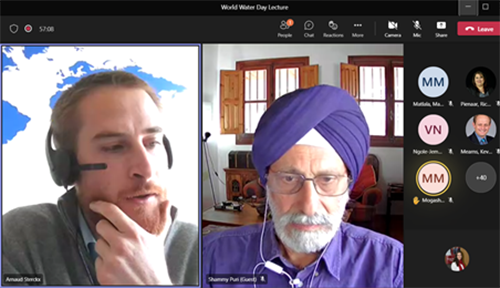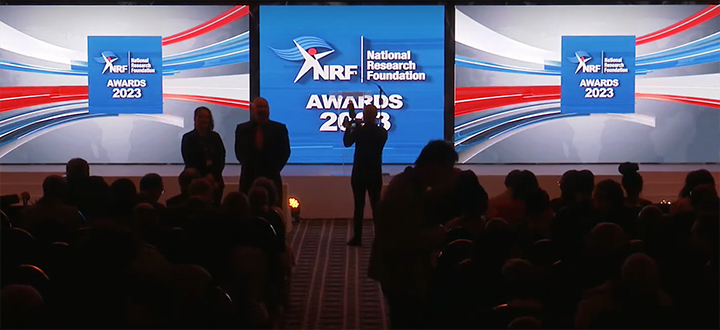College of Agriculture & Environmental Sciences
Groundwater: Making the invisible visible
World Water Day is celebrated annually on 22 March, with National Water Week taking place between 20 and 26 March 2022. These special calendar days are aimed at educating the public about their responsibility in water conservation initiatives and raising awareness around the need to protect and conserve the country’s scarce water resources. The theme for World Water Day 2022 was Groundwater: Making the invisible visible.
The College of Agriculture and Environmental Sciences celebrated World Water Day on 22 March and invited two international speakers to unpack the theme and its importance: Dr Aunard Sterckx, a hydrogeologist from the Netherlands with a background in geology and geography, and Shammy Puri, Director at Sustainable Solutions with Practical Hydrogeology from Oxfordshire in the United Kingdom.
Groundwater use key in rural Africa

Guest speakers Dr Arnaud Sterckx and Shammy Puri
Sterckx delivered a virtual presentation entitled Challenges in sustainable groundwater management.
According to Sterckx, the status of groundwater is as follows:
- Groundwater supplies half of all drinking water in the world.
- Groundwater supplies 43% of global consumptive use in irrigation.
- 67% of all groundwater is used for irrigation (food production).
He highlighted the concerns of groundwater being contaminated and said that agricultural activities using fertilisers and pesticides are a major concern. Domestic and industrial waste and wastewater are another issue, in particular where there is no sewage system or waste collection.
Shallow wells are particularly vulnerable to this sort of contamination. Contamination can also be caused by pumping, such as seawater intrusion or salinisation due to irrigation. Sterckx cited research indicating that contamination is often local, and that it is challenging to identify global patterns.
What are the trends?
- Population growth and socioeconomic development.
- Most (ground)water use will be virtual, in particular in food production.
- The availability and quality of groundwater will be impacted by climate change and land use change, although it is not always clear how.
- In a globalised world, the trajectories of countries and continents are interconnected.
Sterckx brought the issues of groundwater closer to home when he explained groundwater use in Africa. He indicated that based on research, rural water supply depends mostly on groundwater. Several cities rely on groundwater (either via public water supply or domestic wells). Groundwater accounts for 18% of irrigation and some countries on the continent rely almost exclusively on groundwater (Gambia, Libya).
He further highlighted economic water scarcity in Africa. Sterckx mentioned the lack of investment in water supply infrastructure (e.g., boreholes) and that maintenance and actual functionality rates of community boreholes are generally less than 50%.
Groundwater in Africa is estimated to be twenty times more than surface water. It tends to be more reliable than surface water during droughts. According to Sterckx, groundwater can be tapped to meet the current, increasing demand, but in the same vein he also asked to what extent this will continue. “The answer to this question depends on the local hydrogeological and socioeconomical contexts and will require more information than what is currently available,” he said.
Groundwater data collection and management are especially important. Assessment and gap analysis in the SADC member states are based on a literature review and semi-structured interviews with 145 professionals. Gaps were identified in the collection of borehole data, in monitoring, in data storage, QA/QC, interpretation and sharing for each country and for the entire region. A report on the State of Groundwater Data Collection and Data Management in SADC Member States is available.
Cooperation on transboundary aquifers also plays a major role. Several transboundary aquifers have been assessed and dialogues between riparian states have been initiated. Cooperation on transboundary aquifers is being embedded in transboundary river basin organisations, such as ORASECOM and LIMCOM. However, there is no permanent and operational cooperation mechanism on transboundary aquifers in Sub-Saharan Africa.
It is useful to know the main water uses of groundwater in South Africa:
- Irrigated agriculture (66%)
- Mining (15%)
- Domestic water supply (13%)
- Livestock, industry (including power generation), and aquaculture
Because of the increasing socioeconomic pressure on urban water resources, groundwater is increasingly being considered as an alternative resource for urban settlements.
The importance of aquifers
Puri spoke on the topic of Subsurface space: Aquifer ecosystems & quality – implications for humanity.
Puri opened his lecture by posing the following question: Why does subsurface space matter?
His answer was summed up by the following points
- The “space” ranges from microscopic rock pores to huge karstic caves.
- The “pore spaces” in rocks are an immense subsurface store – for fresh water, fossil fuels, geothermal energy.
- The space hosts not only microbial communities suited to specific conditions, but also extractable minerals, though in places containing arsenic, fluoride, and selenium dissolved in potable water.
- More perversely, pesticides and herbicides, if entering the subsurface space in solution with water, are silent executioners, more perilous than an “invading army”
- The global subsurface space needs better appreciation and a committed community of empowered guardians supporting “the sound governance of subsurface space.”
According to Puri, pore spaces in aquifers can occupy 20 to 30% of the volume. But how extensive is the subsurface space? Like Sterckx, his answer was based on Africa. He stated that the estimated total fresh groundwater storage in Africa would be within a range of 0.36–1.75 million km3.
The Nubian sandstone system in Libya contains an estimated 4 850 km3 and is home to 136 million people.
Puri warned that the impact of naturally geogenic contaminants poses a threat, while pesticides, herbicides, and agrochemicals contaminate groundwater.
Focusing specifically on glyphosate (GLY), used in herbicides, the cited findings in Mexico indicated that the highest concentrations of GLY were observed in the groundwater (1.42 μg/L) of Ich-Ek and urine (0.47 μg/L) samples of subsistence farmers from the Francisco J. Mújica communities.
“The glyphosate concentrations in groundwater and bottled drinking water indicate an exposure and excessive use of glyphosate in these agricultural communities,” he said.
Puri asked: “What is being done about this situation today – World Water Day?” he asked. “Nothing … well, almost,” was his conclusion, as he listed the following:
- Sporadic action is underway to fit water treatment to wells tapping geogenic contaminants.
- Pollution arising from human waste is recognised – but some “end of pipe solutions” are recommended.
- Contamination from herbicides, etc is barely recognised and is firmly resisted by the industry.
- MDGs, and now SDGs, simply seek to “deliver the water” – but they hardly have any goals that seek to focus holistically on reconditioning the actual resources.
- The volume of groundwater in the upper 2 km of the Earth’s continental crust (excluding Tundra landscapes) is approximately 22.6 million km3.
- The volume of accessible water is equivalent to a body of water with a depth of about 3 m spread over the continents.
- This is the equivalent global “subsurface space.”
“However,” he said, “there are no concerted actions to halt or reverse the inexorable accumulation of contaminants in the subsurface space.”
In conclusion, Puri said that subsurface space is an asset that should be well managed.
* By Poppie Khoza, Communication and Marketing Specialist, College of Agriculture and Environmental Sciences
Publish date: 2022/04/11

 Unisa co-hosts G20 community outreach in the Eastern Cape
Unisa co-hosts G20 community outreach in the Eastern Cape
 Unisans gain membership of prestigious science academies
Unisans gain membership of prestigious science academies
 Advocating for disability transformation through servant leadership
Advocating for disability transformation through servant leadership
 Unisa Press continues to illuminate the publishing space
Unisa Press continues to illuminate the publishing space